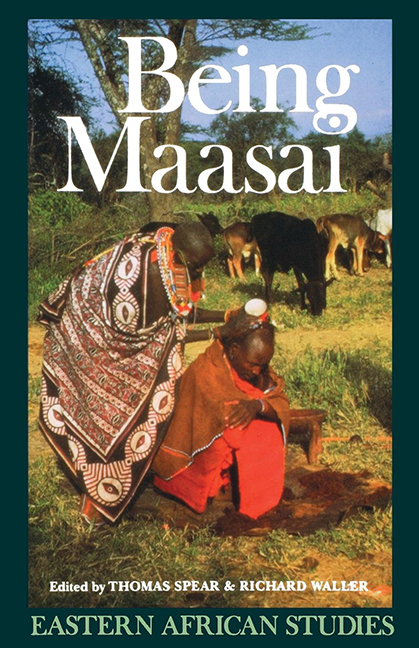Book contents
- Frontmatter
- Contents
- Maps, Figures & Illustrations
- Contributors
- Acknowledgements
- I Introduction
- II Becoming Maasai: Introduction
- III Being Maasai: Introduction
- IV Contestations and Redefinitions: Introduction
- 11 Acceptees and Aliens: Kikuyu Settlement in Maasailand
- 12 Land as Ours, Land as Mine: Economic, Political and Ecological Marginalization in Kajiado District
- 13 Maa-Speakers of the Northern Desert: Recent Developments in Ariaal and Rendille Identity
- V Conclusions
- Bibliography
- Index
13 - Maa-Speakers of the Northern Desert: Recent Developments in Ariaal and Rendille Identity
from IV - Contestations and Redefinitions: Introduction
Published online by Cambridge University Press: 30 August 2017
- Frontmatter
- Contents
- Maps, Figures & Illustrations
- Contributors
- Acknowledgements
- I Introduction
- II Becoming Maasai: Introduction
- III Being Maasai: Introduction
- IV Contestations and Redefinitions: Introduction
- 11 Acceptees and Aliens: Kikuyu Settlement in Maasailand
- 12 Land as Ours, Land as Mine: Economic, Political and Ecological Marginalization in Kajiado District
- 13 Maa-Speakers of the Northern Desert: Recent Developments in Ariaal and Rendille Identity
- V Conclusions
- Bibliography
- Index
Summary
Recent developments among Ariaal and Rendille pastoralists of northern Kenya illustrate the continuing influence of Maasai culture on surrounding peoples. This chapter discusses the spread of the Maa language among Rendille in the contemporary context of pastoral sedentarization and market integration.
The Ariaal, along with Samburu and Elmolo of Lake Turkana, are the most northerly of Maa-speaking peoples. Numbering between 7,000 and 9,000 people, Ariaal herd camels, cattle, goats and sheep between Mount Marsabit and the Ndoto Mountains in Marsabit District, north-central Kenya. The Ariaal form a cultural bridge between Samburu cattle pastoralists (pop. 70,000) and Rendille camel pastoralists (pop. 15,000), and speak both Samburu (a dialect of Maa) and Rendille (a Cushitic language related to Somali).
Paul Spencer (1973) first described the Ariaal as a product of the larger Samburu-Rendille alliance, which was based on the non-competitiveness of their herding environment, their mutual defence against common Turkana and Boran enemies, and, most importantly, the outmigration of Rendille men and women into Samburu society via Ariaal. Spencer proposed that Rendille outmigration was a result of demographic pressures where their human population grew at a faster rater than their camel herds and where their rules of inheritance (by primogeniture) impoverished second and third sons. Poorer Rendille men joined Ariaal settlements near the highlands to take up cattle and small stock production, while women from the essentially monogamous Rendille married more polygynous Samburu and Ariaal men as second wives.
Since Spencer's research in the late 1950s, the Rendille and Ariaal have undergone substantial change in residence and economy. They, as other northern Kenyan pastoralists, have experienced political disruptions following Kenyan independence in 1963, including the shifta civil war in the 1960s, devastating droughts in the 1970s and 1980s, the growth of permanent towns around Christian missions distributing famine-relief foods, and, most recently, the arrival of large-scale international development projects including UNESCO-Integrated Project in Arid Lands. Attracted to growing towns by physical security and mechanized wells for their livestock, Ariaal and Rendille have benefited from new opportunities in wage labour, commercial entrepreneurship, and access to schools and health care.
- Type
- Chapter
- Information
- Being MaasaiEthnicity and Identity in East Africa, pp. 273 - 289Publisher: Boydell & BrewerPrint publication year: 1993

